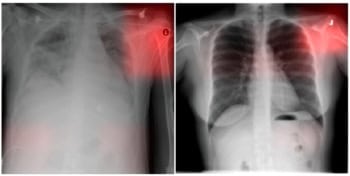
Colorectal cancer is one of the most deadly malignancies, but is preventable and curable if diagnosed at a precancerous or early stage. Optical colonoscopy is a key component of any colorectal cancer screening programme. However, many patients are reluctant to undergo colonoscopy due to its invasive nature and requirements for bowel preparation, sedation and pain medication.
To increase screening uptake, a more patient-friendly test is needed. With this aim, an international research team has developed an ingestible X-ray imaging capsule that requires neither colon cleansing nor sedation. The capsule – which is being commercialized by Israeli diagnostics company Check-Cap – scans the colon as it travels through the gastrointestinal tract and sends data to a dermal patch receiver. The technology could reduce colon cancer mortality by screening for precancerous polyps and lesions before they become malignant.
In preliminary studies, the researchers confirmed the safety of the X-ray capsule in 138 volunteers (Abdom. Radiol. 42 1291). Now, they have published results from the first prospective trial examining its efficacy for polyp detection (Gut 10.1136/gutjnl-2018-316127).
Capsule design
The capsule incorporates a short-lived 191Os radioisotope, which emits three rotating beams of low-dose 65-75 keV X-ray photons, plus photon-counting X-ray detectors. The patient swallows the capsule, along with small quantities of an iodine-based contrast. A scanning control algorithm (SCA) then uses real-time positional data to determine whether the capsule has moved along the colon and, if so, transmits a command to perform a scan.
“Ideally, since the scan width is about 5 mm, the SCA should scan every 5 mm for 100% coverage of the colon surface,” says Yoav Kimchy, founder and CTO of Check-Cap. “In reality, since our focus is on polyps of 10 mm and above, we estimate that a scan every 10 mm, which gives 50% coverage, may still catch most of these polyps.”

The colon wall is imaged based on two processes: generation of secondary X-ray fluorescence (XRF) photons at 27 keV as the emitted photons interact with iodine atoms; and Compton scattering as the photons interact with atoms in the colon wall and lumen, creating scattered photons with energies of 52-60 keV.
“Measuring both XRF and Compton photons brings a number of advantages,” Kimchy explains. “Since both the distance from the capsule [to the colon wall] and the contrast concentration at each imaging location are unknown, having two measurements allows us to solve for distance and concentration simultaneously.”
The system combines the XRF and Compton data to estimate these parameters and reconstruct the colon surface. Kimchy notes that the two techniques behave differently when encountering a gas bubble in the colon, enabling readers to distinguish between a polyp and a bubble. False readings are also reduced by requiring both data sets to confirm the presence of a polyp.
Feasibility study
To test the capsule’s ability to detect polyps, the team analysed imaging data from 45 patients with and without polyps. Patients underwent the capsule procedure and a faecal immunochemical test (FIT, an indirect colorectal cancer detection test), followed by a reference colonoscopy. The researchers calculated the sensitivity and specificity of the capsule findings as a function of the scan imaging density.

The capsule’s overall sensitivity for polyp detection was 44%, compared with 37% for FIT. In a subgroup of 19 patients with scan imaging density above 50%, this increased to 78%, while for 12 patients with imaging density above 70%, sensitivity was 100%. Specificity was high in all cases, at between 86 and 90%.
The average total transit time of ingested capsules was 52±32 hours. There were no device-related serious adverse events and the procedure was well-tolerated by the participants. The average total X-ray dose was 0.051 mSv.
After the trial, the researchers developed an improved SCA and retrospectively implemented it on the study data. This increased the number of subjects with scan imaging density above 50% from 21 of the 45 patients to 41. “The new SCA showed an improvement in the filtering of body movements, providing more homogeneous spread of scans along the colon. This amounts to a better scan imaging density in the retrospective analysis, which we hope will translate to improved sensitivity for polyp detection,” Kimchy explains. “We are collecting new clinical data with this algorithm to show statistics on sensitivity.”
Following CE Mark approval in January 2018, Check-Cap plans for commercial sales of the capsule in Europe, with additional regulatory clearances to market in Israel and the Far East. They are also developing improved software and algorithms, performing a multicentre clinical trial, and working with the FDA to start clinical trials in the USA. In parallel, the company is preparing for high-volume manufacturing, with GE Healthcare as a partner.



